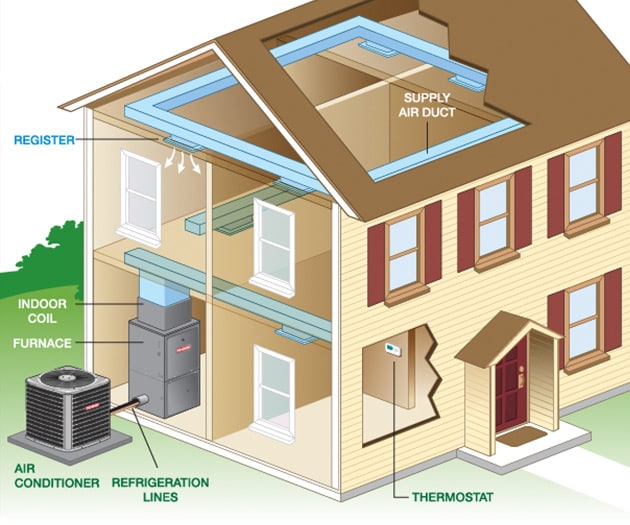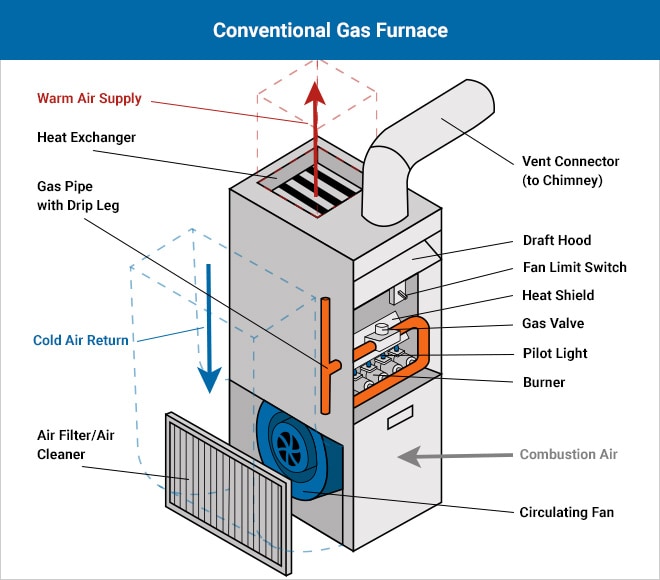
Furnaces 101
Do you wish you had a better grasp on things when the heat goes out and your family is shivering under the blankets? By understanding how your furnace works, you'll know how to keep it running and, if needed, how to replace it.
First, spend a few seconds looking at the diagram below and see how the furnace is connected to ductwork that wraps throughout the house (ignore the air conditioner for now). The air ducts are like the arteries and veins of your home. Instead of blood, they distribute air to and from the heart of the system: the furnace.
When finished, scroll down to learn step-by-step how your furnace works.

Image: Goodman Manufacturing
Basic Heating Cycle
A forced-air furnace heats your home through a heating cycle that looks like this:
- Natural gas or propane is ignited in the furnace's burner.
- The burner flames heat up a metal heat exchanger, while the exhaust flows out the flue.
- The heat exchanger warms incoming cold air.
- The furnace's blower forces the heated air into the ductwork and distributes it throughout the home.
- As the warm air fills each room, the colder, denser air is drawn back into the furnace via the return ducts, repeating the process.
Gas Furnace Components
There are many components that work together in a furnace to help keep you comfortable. With so many types of models on the market, it can be tough to know what they are and their functions.

Here are some of the main gas furnace components to know.
- Thermostat: A temperature-activated switch that signals to the furnace, via a control board, that the home needs heat (indoor temperature dips below a set point). This signal turns on the ignition switch in the furnace to light the burners.
Shop All Thermostats - Draft Hood: The draft hood provides steady airflow within the combustion chamber and prevents backdrafts.
- Draft-Induced Fan: The draft-induced fan draws air into the burner assembly for an even flow and helps vent exhaust gases out of the home.
- Burners: Like a gas grill, furnace burners are a set of tubes through which gas is directed and burned. A gas valve, igniter, and flame sensor all work together to control the flames. When the system calls for heat, the gas valves open, and the mixture is ignited. The flame sensor is a safeguard that shuts off the incoming gas if a flame isn't detected.
- Heat exchanger: A series of metal tubes that are heated by the burners in order to warm the inside air. As gas combusts inside the heat exchanger, these metal baffles get hot and transfer their radiant heat into the passing air. Any damage to the heat exchanger could let combustion gases leak into the house air. High-efficiency furnaces may add additional heat exchangers with curved surfaces (slow down air flow) to increase the rate of heat transfer.
- Blower: The blower, also known as the circulating fan, directs air coming from return ducts into the hot heat exchanger. The heated air is then forced throughout the home's ductwork. Many furnaces will have a "multi-speed" blower that is preset at the time of installation. High-efficiency furnaces come with a variable speed blower that can self-adjust fan speed during operation.
- Flue: The flue vent collects the spent combustion gases used to create heat and carries them outside the home. Galvanized steel is typically used on standard efficiency units, while high-efficiency units use easy-to-install polypropylene venting.
Beyond Basic Functions
Now that you know how basic furnace components work together to keep you comfortable, it will be easier for you to make a selection about which features are important when picking the perfect furnace.
Next, we'll take a deeper look at those features and key considerations you should make for your next furnace.
Learn About Other Central Forced Air Systems
HVAC-101 | Gas Furnaces-101 | Heat Pumps-101 | Packaged Units-101 | Air Conditioning-101 | Air Handlers-101

